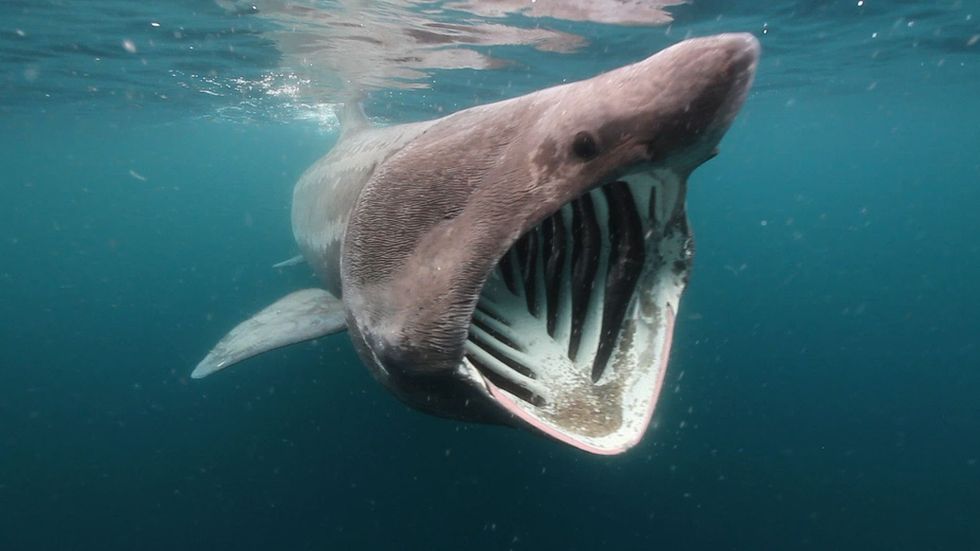Humongous, scary, and tubelike are some of the words to describe the second largest shark in the ocean, the basking shark. The basking shark can grow between 6-10 meters and weigh an outstanding 8,500 pounds (Online sfsu). The basking shark is the second largest living fish, after the whale shark, and one of three plankton-eating sharks along with the whale shark and megamouth shark. The basking sharks are known for their large mouths that can open up to one meter wide (YouTube). The diet of these large sharks consists of zooplankton, copepods, barnacles, decapods’ larvae, and fish eggs (Online sfsu). Basking Sharks can be found in all the oceans, but prefer hot or cold temperatures based on the season (YouTube Shark Academy) . These magnificent creatures undergo a chain of adaptations and many evolutionary processes that leave an impact on food chains and ecosystems.
Adaptation to the environment is a necessary skill that every species needs to master in order to survive. The basking shark has adapted to its environment and niches in the ocean with some ways that include migration, relationships, and body structures. These sharks migrate based on food availability, as they travel to cool coastal areas during the summer and return to warm water seas during the winter (Online sfsu). This is because during the summer zooplankton and other species populate at a faster rate along coastlines, which makes it easier for basking sharks to find food along coasts. The basking shark also change eating habits depending on which one of its preys is less difficult to hunt. For example, when zooplankton can be hard to find, these sharks depend on copepods and barnacles. The basking shark attracts parasites due to its slow movement and large bodies. To deal with these annoying, creatures basking sharks scrape their bodies along rocks and can be caught breaching through the air (YouTube). The basking shark also developed large gill rakers on their side. Gill rakers are cartilaginous projections which point forward and inward from the gill arches in the mouth of the shark, which help the shark in feeding. This adaptation helps the shark filter the water for zooplankton and conserve energy, as when zooplankton levels fall, the gill rakers close (Online sfsu). The basking shark has also made it through many evolutionary processes.
Sharks were first introduced to planet Earth about 425 million years ago during the Silurian period. The first significant evolutionary change dates back to the Carboniferous period. At the end of the Devonian period, many of the fish that swam in the ocean died out before the start of the Carboniferous period. This mass extinction gave sharks the opportunity to flourish, as 45 new species of sharks evolved. Then, during the Permian Period, there was another mass extinction that caused the extinction of 99% of all marine mammals. The few sharks that survived this catastrophe later evolved into many of the sharks we know about today, including the basking shark. The Elasmobranchii subclass of sharks survived the mass extinctions and contains the basking shark and other plate gill sharks (Online sfsu). The evolutionary process of sharks relates to macroevolution in many significant ways. The evolution of sharks follows mass extinction patterns as well as punctuated equilibrium stages. The sharks survived 2 mass extinction which caused new species of sharks to arise in response to the change in environment. Shark evolution also follows the punctuated equilibrium stages with rapid change followed by little change. When mass extinction hit, the shark species were rapidly changing and evolving to better suite their new environments. After the mass extinctions, the varying species slowed down and there was no more fast change. Another type of evolution basking sharks encountered was divergent evolution, as they share common ancestors with the great white shark, “The only living member of the Cetorhinidae family, basking sharks fall within the same shark order as great whites. This ancient order is called mackerel sharks, or Lamniformes, and includes a wide range of species from megamouths to makos, and threshers to goblin sharks. These sharks are grouped together based on physical similarities and DNA evidence,” (Sharkopedia). This clearly shows signs of divergent evolution between great white sharks and the basking shark. Both these sharks share a common ancestor but evolved differently due to different environments and diets. The evolution of the sharks took many millions of years and created new species from different types of changes and similar ancestors. The basking shark has evolved and has adapted to its new living conditions very well. Humans negatively impact basking sharks with many different methods.
The basking shark is a gentle giant, as it does not eat humans or affect our world in any way. To contradict, humans affect sharks in many ways such as entanglement, pollution, and harassment. The basking shark is a massive creature and can easily get tangled up in many fishing nets and ropes. Some sharks can untangle themselves, but others can die if not quickly released. Human pollution is also another factor that contributes to the injuries and even death of some sharks. Chemical toxins can harm the shark's’ body from the inside out by taking over cells and organs. Another way humans negatively impact sharks is through the use of harassment. In many cases of harassment sharks are, “struck by boats or jet-ski’s, and being disturbed by water-users” (Shark Trust). Humans play a major role in the harm and injury of the basking shark, as well as its extinction.
Many species of sharks have been hunted for many years due to their fins having high monetary and cultural value, and their meat which used to make many dishes. Similarly, basking sharks were being hunted for the oil in their liver, their large fins, the meat on their bodies, and their vitamin rich livers. As a result of all their qualities, basking sharks became a relevant topic of discussion among fishermen. During the 1950-1993 time period, basking sharks were excessively hunted which caused the basking shark to end up endangered and almost extinct. This impacted many fishermen trying to earn money by hunting the basking shark. Countries like China and Japan still hunt the basking shark for their fins which are used in shark fin soup, and their livers containing oil that is used for lubricant in cosmetics. One 8,000 pound basking shark can provide a fisherman with up to 2,000 pounds of meat, and about 100 gallons of rich oil (Flmnh). The extinction of the basking shark will cause many problems in the their food chain.
Basking sharks feed on a variety of prey including zooplankton, copepods, fish eggs, and barnacles. If the basking shark was to disappear from existence zooplankton and other prey of the shark will flourish and overpopulate. This short term overpopulation can cause many problems for the food chain in the long run. When the zooplankton overpopulate, their predators will also start to overpopulate, and their prey become endangered. This means that species such as the fry bass will be in abundance while species such as phytoplankton will become scarce. The short term effect of the basking shark leaving its environment will create - over and under populations - of many species. This extinction of the basking shark will impact the whole ecosystem in the long run. The energy flow of the food chain will be inconsistent and messed up on many stages. The biomasses of the different levels in the food chain will also be greatly be changed. All in all, the basking shark is a vital part of its food chain, as without it, the whole ecosystem is affected in a negative way.
To reiterate, basking sharks are some of the largest and endangered species of shark in the ocean. These sharks underwent many adaptations and evolutionary stages that impact whole food chains and ecosystems. Basking sharks are the second biggest shark, as they weigh in at 8,000 pounds and can grow up to 24 feet long. With their humongous mouths and gill rakers, basking sharks are able to bring in a lot of zooplankton, barnacles, copepods, and even fish eggs. These sharks are surprisingly non harmful to humans due to their small throats and little teeth meant for zooplankton. From sucking up water full of zooplankton, to breaching through the air, basking sharks are one of the smartest and most interesting sharks in the world. It's the homo sapiens who have to be responsible for conserving and not hunting these creatures heading for extinction. In order to maintain the harmony of the food chain and have a balance, humans need to think and act accordingly.



















